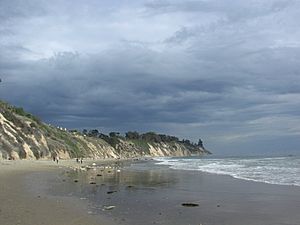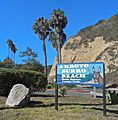Arroyo Burro Beach facts for kids
Quick facts for kids Arroyo Burro Beach Park |
|
|---|---|
| Hendry's Beach | |

Arroyo Burro Beach, looking east, with the Wilcox Property (i.e. the Douglas Family Preserve) atop the cliffs to the left.
|
|
| Location | Cliff Drive, near Hope Ranch in Santa Barbara, California; Located about 5 mi (8.0 km) west of Santa Barbara's city center. |
| Area | 13.8 acres (6 ha) |
| Created | 6 acres (2 ha) purchased (plus 6.8 acres leased) from State in 1947; State granted leased land to County in 1968; 1 acre granted for parking from private land trust in the 1990s |
| Operated by | Santa Barbara County Community Services Department - Parks Division |
| Open | 8am - Sunset |
| Website | Arroyo Burro Beach Park |
Arroyo Burro Beach, often called Hendry's Beach by local people, is a fun public beach in Santa Barbara County, California. You can find it off Cliff Drive. It's where the Arroyo Burro Creek meets the ocean. The beach sits below tall cliffs, next to the Douglas Family Preserve. This preserve is a large open space to the east. The community of Hope Ranch is about 1 mile to the west.
Arroyo Burro Beach is famous as a "dog beach." Many dog owners love to bring their pets here. While the main beach asks for dogs to be on a leash, there's a special off-leash area just east of the beach. Surfers also enjoy the waves here. There are outdoor showers for them to rinse off after surfing.
The park has other cool features too. You'll find a grassy area with picnic tables and barbecue grills. There's also the Arroyo Burro County Park building. This building has a restaurant and snack bar with both indoor and outdoor seating. Another building is made from recycled materials. It's an education center called the Watershed Resource Center. It teaches about the environment. The park opens at 8:00 AM and closes at sunset. You can park for free, but the entrance closes at sunset. However, if your car is already there, you can stay longer into the evening.
A restaurant called The Brown Pelican used to be at the beach. It closed in 2007. A new restaurant, The Boathouse, opened in its place in 2008. It has new owners and a fresh look.
Contents
History of Hendry's Beach
Local people call it Hendry's Beach because of a family who lived nearby. William Nicol Hendry and Anne Stronach Hendry were Scottish immigrants. They lived here with their twelve children. William Hendry came to Santa Barbara around 1872. He first worked on a farm in the Goleta Valley.
By 1884, Hendry leased over 360 acres of land near Arroyo Burro. This included areas like Veronica Springs and parts of Hope Ranch. He grew crops like hay, oats, barley, and especially lima beans. The Hendry family lived in this area until 1918. William sold the farm for $80,000 and moved his family to downtown Santa Barbara.
In 1947, Santa Barbara County bought the land for the park. The State of California helped with this purchase. They bought 5.5 acres and 500 feet of beachfront for $15,000. Later, another 100 feet of beachfront was given to the County. In 1968, the State gave the County an extra 6.8 acres of land for the park. In the 1990s, a private group gave 1 acre of land. This land became an extra parking area for the park.
Protecting the Environment at Arroyo Burro Beach
More than 800,000 people visit Arroyo Burro Beach each year. Sometimes, the beach has had issues with water pollution. This pollution comes from things like oil, grease, and animal waste. These things can get into stormwater and flow into the ocean.
From 2002 to 2006, the beach had high levels of certain bacteria for several days each year. The County has been working to stop this pollution. They want to make sure the water is clean.
From 2006 to 2007, the City of Santa Barbara worked on a project. It was called the Arroyo Burro Estuary and Mesa Creek Restoration Project. This project aimed to improve the natural areas and water quality. They removed an underground pipe that had changed Mesa Creek. This pipe had made the estuary much smaller. It also made the water quality worse and made it hard for fish to move around.
The restoration project helped endangered fish like the Northern tidewater goby. It also helped steelhead trout by making it easier for them to swim.
Even after these efforts, pollution continued in 2010. This was due to sewage spills and other unknown sources. The city worked hard to clean its sewer pipes more often. This reduced spills from 44 in 2009 to 12 in 2011.
In 2011, an environmental group filed a lawsuit. They wanted the City of Santa Barbara to fix its sewer system. In 2012, they reached an agreement. The City started a $26 million plan to improve its sewer pipes. They focused on areas where pollution was a bigger risk.
More efforts have been made to protect Arroyo Burro Creek. The City of Santa Barbara and The Trust for Public Land bought Veronica Springs. This is a 14.7-acre natural area upstream from the park. In 2016, it became a city park and wildlife area. It was renamed Arroyo Burro Park. The City plans to restore the banks of the lower Arroyo Burro creek. This will make the water cleaner and improve homes for wildlife.
Gallery
-
Aerial view of the Arroyo Burro Creek (center), the County Beach (left), and the western edge of the Douglas Family Preserve park atop the mesa (right).
Images for kids





